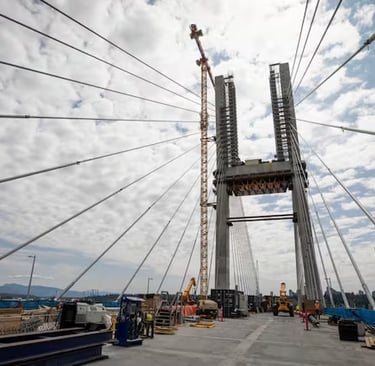After Years of Delays, Pattullo Bridge Replacement Inches Closer to Completion
Sarah Desjardins
6/20/20252 min read


Only 80 metres of bridge deck remain to be connected over the Fraser River as B.C.’s long-awaited Pattullo Bridge replacement project moves toward completion.
“We’re getting really close now,” said Wendy Itagawa, executive director of the Pattullo Bridge Replacement Project. “We’ll be connecting to the north side later this summer.”
The $1.637-billion bridge, originally slated to open in 2023, is now expected to open in fall 2025, two years behind schedule. Delays have been attributed to COVID-related permitting issues, inflation, global supply chain problems, and the complex construction of the bridge’s 167-metre tower — the tallest of its kind in B.C.
A Much-Needed Upgrade
The existing Pattullo Bridge, built in the 1930s, carries around 60,000 vehicles daily but has long been criticized for lacking modern wind and seismic safety standards. A 2016 TransLink report warned that the aging structure needed to be replaced by 2024 to ensure public safety.
The province approved the new bridge in 2018, and construction officially began in early 2020 by Fraser Crossing Partners, who were awarded a $967.5-million construction contract.
The replacement will feature:
Four lanes of vehicle traffic, with room to expand to six lanes in the future.
Separated pedestrian and bike paths on both sides.
A centre median for improved safety — unlike the current bridge where lanes are divided by plastic stakes.
New Bridge, New Name
While the bridge is replacing the existing Pattullo, it will not carry the same name. As part of a cultural recognition initiative, the new bridge will reflect the significance of the Fraser River to local First Nations, including the Musqueam and Kwantlen peoples.
The project will also include Indigenous artwork, such as a large engraving on the Highway 17 overpass by Kwantlen artist Phyllis Atkins, featuring sturgeon and eulachon, fish deeply tied to Indigenous heritage.
“It was life-changing being on the river,” said Atkins. “I really felt that connection to how our people traveled and fished for thousands of years.”
With about 450 workers regularly on-site, crews continue to install deck panels and suspension cables as the final stretch of construction enters its critical phase. If all goes as planned, Metro Vancouver commuters will be crossing the new span within 18 months.
News
Stay updated with the latest BC news stories, subscribe to our newsletter today.
SUBSCRIBE
© 2025 Innovatory Labs Inc.. All rights reserved.
LINKS
